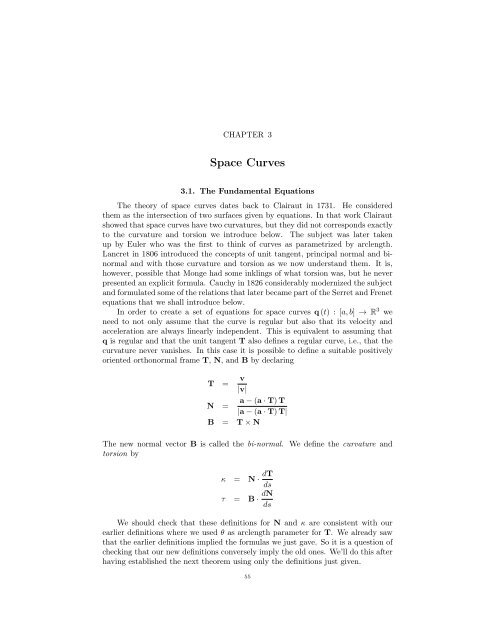Lecture Notes for 120 - UCLA Department of Mathematics
Lecture Notes for 120 - UCLA Department of Mathematics
Lecture Notes for 120 - UCLA Department of Mathematics
You also want an ePaper? Increase the reach of your titles
YUMPU automatically turns print PDFs into web optimized ePapers that Google loves.
CHAPTER 3<br />
Space Curves<br />
3.1. The Fundamental Equations<br />
The theory <strong>of</strong> space curves dates back to Clairaut in 1731. He considered<br />
them as the intersection <strong>of</strong> two surfaces given by equations. In that work Clairaut<br />
showed that space curves have two curvatures, but they did not corresponds exactly<br />
to the curvature and torsion we introduce below. The subject was later taken<br />
up by Euler who was the first to think <strong>of</strong> curves as parametrized by arclength.<br />
Lancret in 1806 introduced the concepts <strong>of</strong> unit tangent, principal normal and binormal<br />
and with those curvature and torsion as we now understand them. It is,<br />
however, possible that Monge had some inklings <strong>of</strong> what torsion was, but he never<br />
presented an explicit <strong>for</strong>mula. Cauchy in 1826 considerably modernized the subject<br />
and <strong>for</strong>mulated some <strong>of</strong> the relations that later became part <strong>of</strong> the Serret and Frenet<br />
equations that we shall introduce below.<br />
In order to create a set <strong>of</strong> equations <strong>for</strong> space curves q (t) :[a, b] ! R 3 we<br />
need to not only assume that the curve is regular but also that its velocity and<br />
acceleration are always linearly independent. This is equivalent to assuming that<br />
q is regular and that the unit tangent T also defines a regular curve, i.e., that the<br />
curvature never vanishes. In this case it is possible to define a suitable positively<br />
oriented orthonormal frame T, N, andB by declaring<br />
T = v<br />
|v|<br />
a (a · T) T<br />
N =<br />
|a (a · T) T|<br />
B = T ⇥ N<br />
The new normal vector B is called the bi-normal. We define the curvature and<br />
torsion by<br />
apple = N · dT<br />
ds<br />
⌧ = B · dN<br />
ds<br />
We should check that these definitions <strong>for</strong> N and apple are consistent with our<br />
earlier definitions where we used ✓ as arclength parameter <strong>for</strong> T. We already saw<br />
that the earlier definitions implied the <strong>for</strong>mulas we just gave. So it is a question <strong>of</strong><br />
checking that our new definitions conversely imply the old ones. We’ll do this after<br />
having established the next theorem using only the definitions just given.<br />
55
















